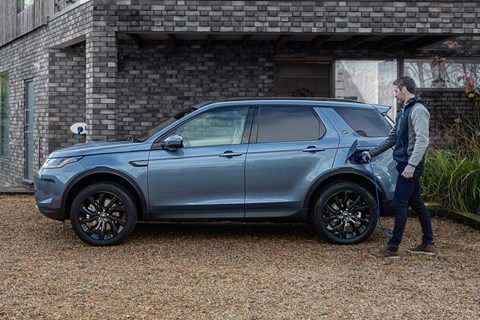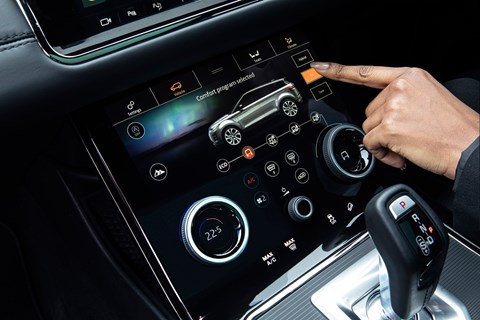► PHEV Disco Sport and Evoque
► 40-mile electric range, quick too
► P300e Evoque from £44k, Disco Sport £45k
The 2020 plug-in hybrid onslaught continues, and this time it’s Land Rover slinging a battery and electric motor at its most affordable models, the Evoque and heavily Evoque-based Discovery Sport.
Except that ‘slinging’ isn’t the right word – the new P300e cars sport a neatly integrated, bespoke petrol/electric powertrain that promises both 300bhp effortlessness and more than 40 miles of silent, electric-only range.
Under the bonnet of both cars you’ll find a 1500cc, three-cylinder version of JLR’s Ingenium turbocharged, in-line petrol engine. Developed for this application, the engine’s more compact than the four (the space it frees up is used to package the PHEV’s many cooling circuits), more efficient (fewer cylinders mean fewer moving parts and less friction) and lighter – the triple’s a full 37kg lighter than the four.

At the same time, the triple uses many parts common to the four- and the six-cylinder engines and is assembled on the same production lines. Peak power is a modest 197bhp (the four’s good for 296bhp in the F-Type), and the engine only ever drives the front axle.
Moving rearward under the car, the PHEVs junk the propshaft and move the exhaust system to one side to create space for the plug-in hybrids’ other systems. As vehicle engineering manager Chris Carey puts it, ‘If you laid all the components on the floor and someone told you to put them in an Evoque, you’d think, “No chance!” But we’ve a couple of new solutions and engineering relationships that make it possible.’.
Under the front seats you’ll find the onboard charger and the power converter, together with an integrated starter/generator that can fire up the petrol engine instantaneously, on demand, while also pumping energy back into the battery via the brake-by-wire system.

Both cars package a 15kWh lithium-ion battery beneath the rear seats, next to a slightly smaller fuel tank and behind 6mm of steel undertray. The battery offers 41 miles of electric range in the Evoque and 38 in the bigger, heavier Disco Sport.
Powering the rear axle is a new-to-JLR, 108bhp GKN electric drive unit capable of regenerative charging, powerful and accurate low-speed drive and control (handy for off-roading) and an electric-only V-max of 84mph. The permanent-magnet motor is housed, together with its inverter and single-speed reduction gearset, in a tough little casing (and NVH jacket) that doesn’t compromise the multi-link rear suspension.
While the rear axle can only be driven electrically, don’t think that compromises either car’s off-road performance. ‘Even at a state of zero of charge we’re always a four-wheel drive car; never two-wheel drive,’ explains engineer Carey. ‘There’s always a minimum state of charge in the battery, and when you engage off-road mode the powertrain puts more charge into the battery. The target was to match the off-road ability of the non-PHEV cars. We’ve surpassed that.’
As well as the off-road functionality you’d expect of a 21st century Land Rover or Range Rover, the PHEVs also get hybrid-specific drive modes that variously prioritise EV running (EV mode), petrol-only power (Save) and a peak-efficiency Hybrid, which talks to the nav system if you’ve entered a destination to optimise your EV deployment.

And regardless of mode, expect a decent turn of speed. While the cars are heavier than their non-PHEV brethren (the Evoque PHEV weighs in at 2082kg versus 1810kg for the D150 auto), a combined output of 305bhp is not to be sniffed at: the Evoque P300 will rattle out 0-62mph in 6.6sec.
Orders are open now.
Check out our Land Rover reviews
Further hybrid car reading